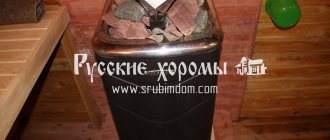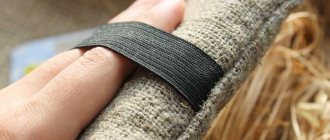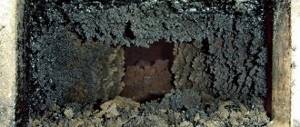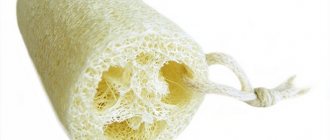Some people, when buying a jute washcloth in a store, are terribly disappointed with it - because... she could turn out to be tough, rude, ugly. But over time it becomes softer, you get used to it. So, a knitted jute sponge or, as it is now called, an eco-scrub with a peeling and deep cleansing effect is just a good gift, if not for dishes, then certainly for the skin. But where can I get it? If you have nowhere to buy it in your city, or you just like to do handicrafts, you like crafts made from juto, then you are welcome - all you have to do is make it yourself.
Washcloth "Mitten" made of jute, crocheted
Master class from Natalia “ECO Gift with Pilling Effect”
If the video materials were not enough, read on for a brief description of how to make a washcloth-mitten for the shower.
To make a washcloth you will need office jute and a hook.
Stationery jute weighing 1.5 kg (to be absolutely precise - 1569 grams)
In general, you can find any crochet pattern you want to try. The only thing is that the pattern should be semicircular on one side of the mitten, and straight on the other.
Ready “front” side and “back”.
Here is the result - the “face” and “back” are connected, a loop is attached for hanging on a hook. The finished washcloth-mitten is slightly larger than the palm of your hand so that you can put it on your hand:
One washcloth takes about 75 grams of thread and approximately 3 hours of time, if you take your time, periodically glancing with one eye at the computer screen with a movie and sipping tea.
Next, wash the washcloth, dry it and steam it with an iron, so it will become more pleasant to the touch.
Sisal
The natural material is fiber from the leaves of the agave plant. Sisal is mined in Brazil and Mexico. Ropes are woven from coarse, densely twisted fiber, and thin threads are used to make washcloths.
The popular bookmaker has released a mobile application for Android, you can follow the link absolutely free.
Sisal accessories are the toughest washcloths, so you need to choose them wisely. In order not to rip off the delicate skin, it is better to use coarse washcloths. The face is not washed with sisal washcloths; the skin of the heels and feet needs rough cleaning. The accessory will remove steamed corns and calluses well.
Expert opinion
Evgenia Katyshkina
Household and farm management specialist
Sisal washcloths should be regularly treated with antimicrobial compounds and dried well. With proper use, it is suitable for use for six months.
The simplest round sponge for washing dishes made of jute
Jute thread is very stiff, so it is better to use a large metal hook. For one sponge you will need a small skein of jute thread (costs from 70 rubles per 100 meters, sold in craft stores), a hook (preferably thick and metal, since loose knitting is needed), scissors.
A round sponge is quite easy to make if you already have at least minimal crochet skills (remember your school craft lessons). You need to cast on five air loops, then loop. Next, knit in a circle, not forgetting about double crochets and adding the number of air loops at your discretion. Do not knit tightly, but pull out the loops, since the sponge should have gaps so that it dries well after use. You can knit some kind of pattern - it depends on your imagination. The round piece should be slightly larger than your palm in size, since then the sponge will “sit” in the water. You need to knit two identical ones, and then fasten them together with the same jute, leaving a small hole for the soap. The ends of the threads can be cut off, hidden, or made into a loop - you can hang a sponge on it next to the sink.
Such a sponge can completely decompose in 3 months, compared to the usual hundreds of years of decomposition of an ordinary commercial washcloth. You can imagine how many of our washcloths are already in landfills, especially if we changed them often, as recommended by all hygiene standards..
Compared to a regular sponge, a jute sponge wins on at least two points: firstly, it completely decomposes in three months (to do this, after cleaning, just put it on the bottom of a flower pot - this will also serve as drainage for the plant), and not in 200 years, and will also last in the kitchen not for a week or two, but up to a year or even longer. When using, it is important to remember that the sponge must be rinsed and dried thoroughly. It is also recommended to pour boiling water over it once a week to disinfect it. If at some point the sponge stretches and loses its aesthetic appearance, you can soak it in a soda solution and it will come off.
Jute
Jute fiber is well known to land owners; durable bags are made from the fibers. Fine threads make excellent washcloths. In terms of rigidity, jute accessories are slightly inferior to sisal ones, but they also clean the body of dirt well. You can use jute washcloths to wash your entire body, not just rough areas of the skin. Usage period is up to 5 months.
To soften a new jute sponge, soak it in boiling water for at least 6 hours. Some housewives pre-soak the product in water with boric acid - this way the jute fiber becomes not only soft, but also safe for allergy sufferers.
How to make a jute washcloth softer?
For me, a person of the principle “what I see, I sing,” words are very important! And the description of the product is exactly the same. My every word, spoken or written, is confirmed by action. And, if I wrote that my jute washcloth is “processed and ready for use, you just need to remove the packaging,” then this means that the washcloth is really processed with the frenzy of a terry perfectionist and is safe to use even internally (but it’s better not to, because it doesn’t tasty). And so I decided to show you the process of this most thorough processing:
2 photos - freshly knitted washcloths, hard, prickly, completely unsuitable for use (in my opinion)
3 photos - I soak and wash the washcloths by hand in a mixture of rather aggressive detergents (I prefer more or less natural ones). The water after this process is like that swamp slurry
4 photos - thorough rinsing. The water is already cleaner, but not quite yet
5 photos - washing washcloths with handmade soap and coconut oil. I wash, scrub, and rinse each washcloth separately.
6 photos - I steam it in very, very hot water (almost boiling water) for 20-30 minutes. Then I rinse it one last time.
7 photos - washcloths are dried in the sun in summer, in the cold in winter
8 photos - already pleasant to the touch, clean, fragrant washcloths are being preened - I sew on tags, loops, pack them, seal them in bags with instructions.
And now, in full bloom and in the best possible shape, the washcloths go on sale. By the way, the photo shows very clearly how the structure of the jute thread changes. Remember this difference well! This will help you distinguish between a treated and safe loofah and a dishonest and unkempt one.
Variety of materials
To understand how to choose a washcloth for the body, let’s consider what materials are used in their manufacture, and what bath sponges are made from.
1) Natural Russian:
- fibers or yarn of cotton, flax, nettle, rhubarb, hemp;
- wool;
- tree bark – linden or willow bast, birch bark;
- loofah;
- exotic: steel (wire or shavings), expanded clay, stone fiber - as composite elements.
2) Natural imported: jute, copra, sisal, ramie (Chinese nettle), bamboo, manila fiber, silk, rubber, sea sponge, volcanic pumice.
3) Synthetic: nylon, nylon, polyethylene, viscose, acrylic, polypropylene (wonderful material), artificial rubber (rubber sponge).
Natural ones not only perform the main function of body care, but also provide an additional healing effect. For example, a bast washcloth distributes beneficial phytoncides. It’s a pleasure to wash with it, the only pity is that it doesn’t last long and is currently an infrequent guest on the counter. A washcloth-glove made of coarse wool is suitable for the hamam; you cannot go there with a rubber sponge. The atmosphere itself and the oriental flavor will not allow it. In addition, one of the hamam procedures is rubbing the body without soap, massage with cleansing. It is clear that this requires a rigid material with high hygroscopic properties, that is, natural fibers or sea sponge. By the way, the latter makes very good baby washcloths.
But natural washcloths, in addition to their fragility and sometimes disposability, have one big drawback. They represent an environment in which pathogenic bacteria quickly multiply and rotting processes occur, no matter how thoroughly you wash it or heat-treat and dry it.
Synthetic washcloths are easy to clean and machine washable; they can be treated with disinfectants. They are durable, especially polypropylene, and can come in different colors, shapes and styles.
However, not every synthetic material can withstand high temperatures, and with low quality there is a danger of releasing harmful substances. Allergic susceptibility may worsen in a hot bath. Many synthetic components are allergens. You need to choose a washcloth wisely.
Photos of beautiful jute washcloths for dishes, for the body and more
Loofah
The loofah looks like a hollow “zucchini” with a fibrous “skin”. And, by the way, the plant is classified as a pumpkin species; loofah is grown in Africa. Among the variety of loofahs, there are varieties from which washcloths and water filters are made, and there are also types suitable for consumption.
Some gardeners grow loofahs in their plots, but ready-made loofahs are also inexpensive. The accessory lasts until it wears out. When wet, the washcloth is soft and convenient for washing the entire body, including delicate skin. The natural properties of the loofah will be appreciated by all beauties - a washcloth will replace the most expensive and effective scrub. Small particles of fiber do a good job of cleaning off the top rough layer of skin, washing off the body without any residue.
Eco-friendly, inexpensive and safe dishwashing sponges
When the loofah sponge becomes unsuitable for use in the bathroom, it should be cut into washers and used for washing dishes.
Useful hand-made: making accessories for the soul and shower with your own hands
Sea sponges
A shower sponge is an intimate personal hygiene device that is found in every home. Lately, high-quality sponges and washcloths that can be used to wash really well have become increasingly rare on sale.
All of them are made of synthetic fabric, and their weaving is sometimes very far from ideal. Therefore, reasonable remarks that any similar bathroom accessory can be bought in a store are not very appropriate here.
Natural bristles
Pig bristles or horsehair are popular materials for making washcloths. Products made from horsehair are more expensive, but short bristles last longer and clean rough areas of the skin better.
There are two types of brushes:
- the bristles are sewn onto the base, letting the ends out, you get a regular brush with a handle;
- Horse hair is woven into ropes, which are then tied into a washcloth in the form of a cloth, mittens, etc.
Both types of products cope well with cellulite and fluid stagnation in the muscles. Natural hair and stubble are not afraid of abrasives, so they can be used together with scrubs and anti-cellulite creams, during dry massage.
What natural products can replace washing powder?
From tights: household items
The list of useful household items that can be made from tights is probably endless. We tried to collect the simplest and most ingenious ideas.
Laundry bag
An old stocking can come out as a bag for washing delicate items: underwear and other, even whole tights. However, you should not put white underwear in a black stocking bag, as it may turn gray. It's simple: take an old stocking, put panties and bras or tights and stockings inside, then wash it on the appropriate delicate cycle. If you have accumulated a lot of old stockings, then you can distribute the laundry into 3-4 at once, without putting everything in one stocking. This will make washing more efficient.
Dishwashing sponge
Nylon does not rot, and therefore thrifty housewives like to make washcloths for washing dishes from tights or old nylon stockings. To make such a washcloth, take a stocking or cut off the “leg” of tights, roll it into a ring - the washcloth is ready! You can, as we have already mentioned, make a more complex design: fold the stocking or tights several times, place pieces of soap (remnants) inside, and sew them up. With this washcloth you can wash dishes without detergent until the soap inside runs out.
Insulation
Plastic windows and doors are not without their drawbacks, and in winter it can even “blow” from under a plastic balcony door. To solve this problem without cost, just have a package of old unnecessary tights. Cut the stockings from the tights and stuff them with leftover tights and other knitwear. You will end up with something like sausage. Tie this stocking “sausage” at the ends, pull the ends, and then place it under balcony doors and on window sills. Such insulation will act as a screen that blocks the flow of cold air.
Vacuum cleaner attachment
It happens that you can’t find a small thing that has fallen on the carpet: an earring, a bead, a nail, etc. In this case, you can follow the recommendation of resourceful Soviet women: take an old stocking, put it on the tube of a vacuum cleaner and vacuum the surface. Lost change will get stuck in a stocking.
Sachet
Sachets are small bags filled with aromatic dried herbs. They are used to scent rooms and placed in closets to repel moths. A tights sachet is made simply: cut the tights into rectangles (across the “legs”), tie them at one end, put aromatic herbs (lavender, tansy), small conifer cones or even sawdust inside, but to do this, make a bag in several layers, then tie it the other end. The shape should be something reminiscent of candy. Sasha is ready! Use in accordance with its intended purpose.
Where do you put your worn-out tights?
Giving socks to your own husband means separation at best, and divorce at worst.
Giving socks to someone else's husband is a sign of a new relationship. — bracatuS
Tags From tights, worn tights
Results
If you look at examples of photos of do-it-yourself washcloths in books, brochures, craft magazines or on the Internet, you will see what a variety of these bath items there are. In addition to the original accessory, spending a minimum of time and effort, you will receive a real decoration for the bathroom, an indispensable cleanser suitable for your skin and save money.
Such washcloths can be given as a gift or an addition to a gift, or they can also be sewn for children in the form of various animals or cartoon characters. The child will be more willing to bathe with such a gift.
Threads come in different thicknesses. The thicker the thread, the tougher the finished washcloth will be. Select threads of such thickness that it is convenient to use them for crocheting No. 3-4. Although the most delicate and soft washcloths are crocheted No. 2, i.e. thin threads. Some people like washcloths that are harder and denser, while others like them softer.
Buy bright threads to match your bath accessories. For children, it is better to knit a washcloth from thin threads in the shape of a mitten or a funny animal.
Before the first use, be sure to keep the washcloth in boiling water for 5-7 minutes, the washcloth becomes pleasant to the body and lathers well.
A washcloth with elongated polypropylene loops can be knitted in the form of a pipe in a circle. It is convenient to insert foam rubber into such a washcloth.
- You can knit a flat rectangular washcloth according to the usual pattern using single crochets (only every third row is knitted with elongated loops):
- The crocheted washcloth can be oval-shaped (in this case, every third row is also knitted with elongated loops):
- A washcloth can be crocheted in the form of a mitten:
- Round washcloth (do not forget to knit every 2 or 3 rows with elongated loops):
- A crocheted washcloth for a child can be crocheted in the shape of any toy.
There is one more nuance: the longer the loops, the softer the washcloth.
If you have never knitted with elongated loops, then you should first try to knit a sample from simple threads in order to practice and work out the tightness of the knitting. The fact is that you need to knit tightly with long loops, i.e. Tighten each loop with columns so that the fabric is not loose. It will be especially difficult for beginners to immediately knit elongated loops from polypropylene threads.
Ramie
This is a crop that is grown for technical needs. Chinese nettle or ramie fiber is extremely durable and can withstand changes in temperature and humidity. There is no need to dry such an accessory, but rinsing it with peroxide from time to time won’t hurt. The hardness of the washcloth is average, the accessory lasts for about 4 months.
To soak a ramie fiber washcloth, soak the product in boiling water for 3 hours. If there is any doubt about the purity of the material, add half a glass of baking soda to boiling water. After soaking, rinse the washcloth under running clean water.
From tights: rugs
Rugs made from tights can be said to replace homespun rugs. Someone who has grandmothers who are needlewomen brings old tights to them “for recycling,” and after a while the grandmothers literally work wonders and create bright and, in principle, practical rugs from tights. And, importantly, at absolutely no additional cost, using only a crochet hook.
Tights rug
Natural sea sponge
Sea sponge is the only natural material that lasts an incredibly long time. When dry, the sponge can be hard, but in water it instantly softens, foams well and does not cause allergies.
It is permissible to use a sponge to wash delicate areas of the skin, face, and bathe babies. The material gently cleanses pores, iodine components and active biological substances promote wound healing, help cure inflammation, and relieve peeling.
Washcloths made from sea sponge are characterized by a high degree of softness, so they are not suitable as a natural scrub, and it is better not to use the product with abrasive compounds, so as not to clog the pores of the sponge.










